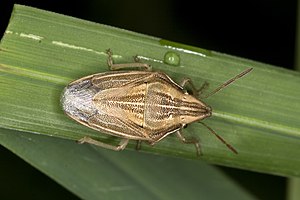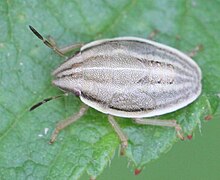Grain bug
| Grain bug | ||||||||||||
|---|---|---|---|---|---|---|---|---|---|---|---|---|

Grain bug ( Aelia acuminata ) |
||||||||||||
| Systematics | ||||||||||||
|
||||||||||||
| Scientific name | ||||||||||||
| Aelia acuminata | ||||||||||||
| ( Linnaeus , 1758) |
The chinch bug ( Aelia acuminata ), also pointed Ling called, is a bug in the family of stink bugs (Pentatomidae).
features
The bugs are 7.8 to 9.3 millimeters long. The species is named for its elongated, pointed head, which is characteristic of the species. Their body is yellowish-white in color and has several brown stripes on the top. The body is finely structured in dots, these dots being light on the light parts of the body and dark on the dark parts. In addition to the shape of the head, two small black spots on the thighs ( femora ) of the middle and rear legs are characteristic of the species. Your pronotum is widened like a plate.
Occurrence and habitat
The species is distributed throughout Europe, with the exception of the far north, to North Africa and in the east to Siberia and across Central Asia to northern China. It is widespread and mostly common in Central Europe and occurs in the Alps up to about 1300 meters above sea level. A large number of different sunny to partially shaded habitats with different moisture levels and soil compositions are colonized. However, the species avoids cool and too humid habitats.
Way of life
The grain bug sucks on many different species of sweet grass (Poaceae), such as B. especially on fescue ( Festuca ), panicle grasses ( Poa ), ostrich grasses ( Agrostis ), ball grasses ( Dactylis ), Lolch ( Lolium ) and bromides ( Bromus ). The females lay their eggs on the leaves of the food plants below the ear. The clutch consists of about twelve eggs, which are laid in double rows. The nymphs appear from May to July, less often into September. The adult animals of the new generation appear from July. They are very active in flight in autumn and often sit on herbaceous plants and woody plants. Occasionally one can still observe matings in Central Europe from September to November, i.e. before wintering. In the first half of the 20th century, the species was considered to be a pest on grain, especially on wheat, but has practically completely lost its significance today.
supporting documents
Individual evidence
- ^ A b c Ekkehard Wachmann , Albert Melber, Jürgen Deckert: Bugs. Volume 4: Pentatomomorpha II: Pentatomoidea: Cydnidae, Thyreocoridae, Plataspidae, Acanthosomatidae, Scutelleridae, Pentatomidae. (= The animal world of Germany and the adjacent parts of the sea according to their characteristics and their way of life . 81st part). Goecke & Evers, Keltern 2008, ISBN 978-3-937783-36-9 , pp. 98 .
- ↑ Spitzling, grain tip bug - Aelia acuminata (LINNAEUS, 1758). www.natur-in-nrw.de, accessed on November 20, 2013 .
literature
- Ekkehard Wachmann , Albert Melber, Jürgen Deckert: Bugs. Volume 4: Pentatomomorpha II: Pentatomoidea: Cydnidae, Thyreocoridae, Plataspidae, Acanthosomatidae, Scutelleridae, Pentatomidae. (= The animal world of Germany and the adjacent parts of the sea according to their characteristics and their way of life . 81st part). Goecke & Evers, Keltern 2008, ISBN 978-3-937783-36-9 .

